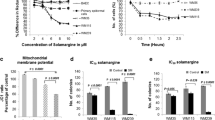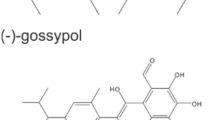Abstract
Angelicin is structurally related to psoralens, a well-known chemical class of photosensitizers used for its antiproliferative activity in treatment of different skin diseases. To verify the activity of angelicin, we employed human SH-SY5Y neuroblastoma cells to investigate its cytotoxicity, although its mechanism of action has not yet been fully elucidated. Here, we examined the cellular cytotoxicity of angelicin by cell viability assay, DNA fragmentation by DNA ladder assay, and activation of caspases and Bcl-2 family proteins by western blot analyses. The results of our investigation suggest that angelicin increased cellular cytotoxicity in a dose- and time-dependent manner with IC50 of 49.56 μM at 48 h of incubation. In addition, angelicin dose-dependently downregulated the expression of anti-apoptotic proteins including Bcl-2, Bcl-xL, and Mcl-1 suggesting the involvement of the intrinsic mitochondria-mediated apoptotic pathway which did not participate in Fas/FasL-induced caspase-8-mediated extrinsic, MAP kinases, and PI3K/AKT/GSK-3β pathway. Furthermore, we clarified the dose-dependent upregulation of caspase-9 and caspase-3 which indicated that angelicin-induced apoptosis is mediated primarily through the intrinsic caspase-mediated pathway. In particular, the caspase-3 inhibitor, DEVD-fmk, induced a reduction in angelicin-induced cytotoxicity which confirmed that the intrinsic caspase-dependent pathway during this apoptosis which did not prevent cytotoxicity using MAP kinases and GSK-3 inhibitor. Taken together, our data shows that angelicin is an effective apoptosis-inducing natural compound of human SH-SY5Y neuroblastoma cells which suggests that this compound may have a role in future therapies for human neuroblastoma cancer.




Similar content being viewed by others
References
Maris JM, Hogarty MD, Bagatell R, Cohn SL (2007) Neuroblastoma. Lancet 369:2106–2120
Nicolini G, Miloso M, Zoia C, Di Silvestro A, Cavaletti G, Tredici G (1998) Retinoic acid differentiated SH-SY5Y human neuroblastoma cells: an in vitro model to assess drug neurotoxicity. Anticancer Res 18:2477–2481
Castel V, Grau E, Noguera R, Martinez F (2007) Molecular biology of neuroblastoma. Clin Transl Oncol 9:478–483
Lampronti I, Bianchi N, Borgatti M, Fibach E, Prus E, Gambari R (2003) Accumulation of gamma globin mRNA in human erythroid cells treated with angelicin. Eur J Haematol 71:189–195
Mosti L, Lo Presti E, Menozzi G, Marzano C, Baccichetti F (1998) Synthesis of angelicin heteroanalogues: preliminary photobiological and pharmacological studies. Farmaco 53:602–610
Komura J, Ikehata H, Hosoi Y, Riggs AD, Ono T (2001) Mapping psoralen cross-links at the nucleotide level in mammalian cells: suppression of cross-linking at transcription factor- or nucleosome-binding sites. Biochemistry 40:4096–4105
Bordin F, Dall’Acqua F, Guiotto A (1991) Angelicins, angular analogs of psoralens: chemistry, photochemical, photobiological and phototherapeutic properties. Pharmacol Ther 52:331–363
Dall’Acqua F, Viola G, Vedaldi D (2004) Cellular and molecular target of psoralen. In: Hoorspool WM, Lenci F (eds) CRC handbook of organic photochemistry and photobiology. CRC Press, Boca Raton USA, pp 1–17
Kim R (2005) Recent advances in understanding the cell death pathways activated by anticancer therapy. Cancer 103:1551–1560
Orrenius S (2004) Mitochondrial regulation of apoptotic cell death. Toxicol Lett 149:19–23
Cory S, Huang DC, Adams JM (2003) The Bcl-2 family: roles in cell survival and oncogenesis. Oncogene 22:8590–8607
Kroemer G, Reed JC (2000) Mitochondrial control of cell death. Nat Med 6:513–519
Goyal L (2001) Cell death inhibition: keeping caspases in check. Cell 104:805–808
Moore JO, Palep SR, Saladi RN, Gao D, Wang Y, Phelps RG, Lebwohl MG, Wei H (2004) Effects of ultraviolet B exposure on the expression of proliferating cell nuclear antigen in murine skin. Photochem Photobiol 80:587–595
Sakahira H, Enari M, Nagata S (1998) Cleavage of CAD inhibitor in CAD activation and DNA degradation during apoptosis. Nature 391:96–99
Viola G, Fortunato E, Cecconet L, Disaro S, Basso G (2007) Induction of apoptosis in Jurkat cells by photoexcited psoralen derivatives: implication of mitochondrial dysfunctions and caspases activation. Toxicol In Vitro 21:211–216
Viola G, Fortunato E, Cecconet L, Del Giudice L, Dall’Acqua F, Basso G (2008) Central role of mitochondria and p53 in PUVA-induced apoptosis in human keratinocytes cell line NCTC-2544. Toxicol Appl Pharmacol 227:84–96
Lampronti I, Bianchi N, Zuccato C, Dall’acqua F, Vedaldi D, Viola G, Potenza R, Chiavilli F, Breveglieri G, Borgatti M, Finotti A, Feriotto G, Salvatori F, Gambari R (2009) Increase in gamma-globin mRNA content in human erythroid cells treated with angelicin analogs. Int J Hematol 90:318–327
Adams JM, Cory S (2007) Bcl-2-regulated apoptosis: mechanism and therapeutic potential. Curr Opin Immunol 19:488–496
Strasser A (2005) The role of BH3-only proteins in the immune system. Nat Rev Immunol 5:189–200
Youle RJ, Strasser A (2008) The BCL-2 protein family: opposing activities that mediate cell death. Nat Rev Mol Cell Biol 9:47–59
Cory S, Adams JM (2002) The Bcl2 family: regulators of the cellular life-or-death switch. Nat Rev Cancer 2:647–656
Breckenridge DG, Xue D (2004) Regulation of mitochondrial membrane permeabilization by BCL-2 family proteins and caspases. Curr Opin Cell Biol 16:647–652
Li P, Nijhawan D, Budihardjo I, Srinivasula SM, Ahmad M, Alnemri ES, Wang X (1997) Cytochrome c and dATP-dependent formation of Apaf-1/caspase-9 complex initiates an apoptotic protease cascade. Cell 91:479–489
Antonsson B, Martinou JC (2000) The Bcl-2 protein family. Exp Cell Res 256:50–57
Jin Z, El-Deiry WS (2005) Overview of cell death signaling pathways. Cancer Biol Ther 4:139–163
Danial NN (2007) BCL-2 family proteins: critical checkpoints of apoptotic cell death. Clin Cancer Res 13:7254–7263
Martelli AM, Cappellini A, Tazzari PL, Billi AM, Tassi C, Ricci F, Fala F, Conte R (2004) Caspase-9 is the upstream caspase activated by 8-methoxypsoralen and ultraviolet-A radiation treatment of Jurkat T leukemia cells and normal T lymphocytes. Haematologica 89:471–479
Khosravi-Far R, Esposti MD (2004) Death receptor signals to mitochondria. Cancer Biol Ther 3:105–1057
Le-Niculescu H, Bonfoco E, Kasuya Y, Claret FX, Green DR, Karin M (1999) Withdrawal of survival factors results in activation of the JNK pathway in neuronal cells leading to Fas ligand induction and cell death. Mol Cell Biol 19:751–763
Kasibhatla S, Brunner T, Genestier L, Echeverri F, Mahboubi A, Green DR (1998) DNA damaging agents induce expression of Fas ligand and subsequent apoptosis in T lymphocytes via the activation of NF-kappa B and AP-1. Mol Cell 1:543–551
Faris M, Kokot N, Latinis K, Kasibhatla S, Green DR, Koretzky GA, Nel A (1998) The c-Jun N-terminal kinase cascade plays a role in stress-induced apoptosis in Jurkat cells by up-regulating Fas ligand expression. J Immunol 160:134–144
Kolbus A, Herr I, Schreiber M, Debatin KM, Wagner EF, Angel P (2000) c-Jun-dependent CD95-L expression is a rate-limiting step in the induction of apoptosis by alkylating agents. Mol Cell Biol 20:575–582
Brady MJ, Bourbonais FJ, Saltiel AR (1998) The activation of glycogen synthase by insulin switches from kinase inhibition to phosphatase activation during adipogenesis in 3 T3-L1 cells. J Biol Chem 273:14063–14066
van Weeren PC, de Bruyn KM, de Vries-Smits AM, van Lint J, Burgering BM (1998) Essential role for protein kinase B (PKB) in insulin-induced glycogen synthase kinase 3 inactivation characterization of dominant-negative mutant of PKB. J Biol Chem 273:13150–13156
Takahashi-Yanaga F, Sasaguri T (2009) Drug development targeting the glycogen synthase kinase-3beta (GSK-3beta)-mediated signal transduction pathway: inhibitors of the Wnt/beta-catenin signaling pathway as novel anticancer drugs. J Pharmacol Sci 109:179–183
Maurer U, Charvet C, Wagman AS, Dejardin E, Green DR (2006) Glycogen synthase kinase-3 regulates mitochondrial outer membrane permeabilization and apoptosis by destabilization of MCL-1. Mol Cell 21:749–760
Cappellini A, Tazzari PL, Mantovani I, Billi AM, Tassi C, Ricci F, Conte R, Martelli AM (2005) Antiapoptotic role of p38 mitogen activated protein kinase in Jurkat T cells and normal human T lymphocytes treated with 8-methoxypsoralen and ultraviolet-A radiation. Apoptosis 10:141–152
Acknowledgments
We thank Dr. Jae-Yong Lee for providing us with the human SH-SY5Y neuroblastoma cell line. This research was supported by a grant of the Korea Healthcare Technology R&D Project, Ministry of Health & Welfare (A090792) and Basic Science Research Program through the Natural Research Foundation of Korea (NRF) funded by the Ministry of Education, Science and Technology (2011-0003931, 2011-0005281), the Republic of Korea.
Author information
Authors and Affiliations
Corresponding author
Rights and permissions
About this article
Cite this article
Ataur Rahman, M., Kim, NH., Yang, H. et al. Angelicin induces apoptosis through intrinsic caspase-dependent pathway in human SH-SY5Y neuroblastoma cells. Mol Cell Biochem 369, 95–104 (2012). https://doi.org/10.1007/s11010-012-1372-1
Received:
Accepted:
Published:
Issue Date:
DOI: https://doi.org/10.1007/s11010-012-1372-1




